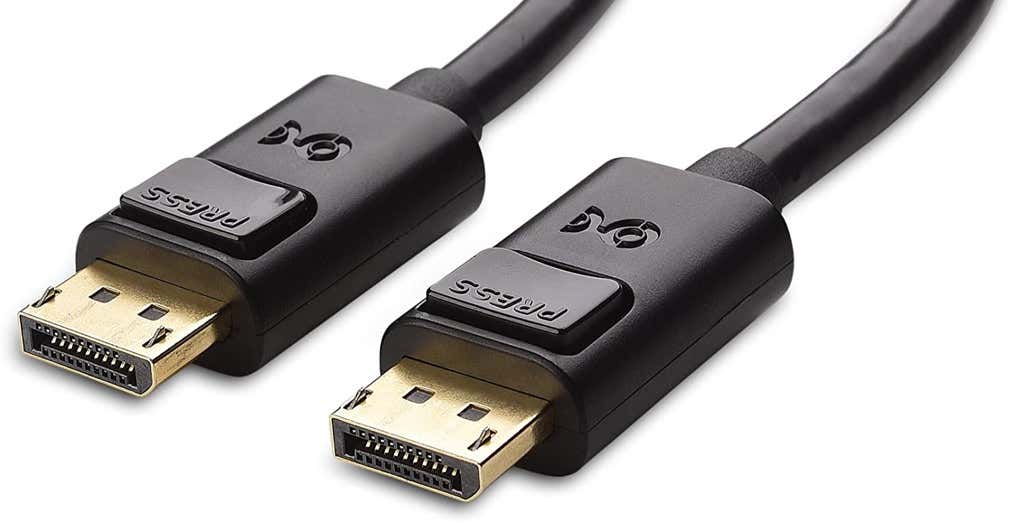Fix DisplayPort No Signal Easily
DisplayPort is a signal interface standard for digital monitors. In some cases, users encounter an error indicating no signal when the appropriate cable is connected. If you personally encounter this error, we will tell you several ways to fix it.
Use the following methods one by one. If one strategy doesn’t help you, go to the next.

Disconnect and reconnect the DisplayPort cable
If your DisplayPort cable is not detecting a signal from your computer, disconnect and reconnect the cable. Make sure the DisplayPort of your PC is clean and free of dirt and dust before reconnecting the cable. Also, no foreign objects should obstruct the contact between the cable, your PC, and the DisplayPort monitor.
Use a can of compressed air to remove foreign objects from the DisplayPort on the monitor and computer. If your laptop uses a DisplayPort adapter, make sure the cable is appropriately connected to the adapter and the adapter is connected correctly to the computer. Switch the cable to a different DisplayPort if the adapter has more than one port.
Install monitor drivers
Some external monitors have drivers powering specific components or functions of the device. If your monitor requires the installation of a driver or related application, be sure to do so. Otherwise, the monitor may not detect the DisplayPort signal from your device. Read the manual for your monitor or contact the manufacturer to determine if the device requires a support driver or application to work correctly.
Select the correct input source
Make sure you use the menu to select the correct active input source the DisplayPort cable is connected to if the monitor has more than one DisplayPort. Suppose the monitor has two DisplayPorts, DP1 and DP2. The input source of the monitor should be set to DP1 if your computer is connected to the first DisplayPort or DP2 for another DisplayPort.
Read the manual for your monitor to find out how the monitor’s DisplayPorts are configured and how to switch the active input between the ports.
Use another DisplayPort cable or computer
The following situations can lead to the error we are discussing:
- DisplayPort of the monitor may be damaged;
- The cable may be loose in the port;
- The DisplayPort cable is damaged, frayed, or not up to standards.
Use the DisplayPort cable on another monitor to ensure it is in good condition. If the problem persists, the problem may be caused by a damaged cable.
We highly recommend using a DisplayPort cable that comes with your monitor. Many monitor manufacturers have offline and online stores where you can purchase original accessories for your devices. If you buy from third-party vendors, make sure the cable you use or purchase is DisplayPort certified.
Reboot the graphics driver of your PC
The Windows operating system has many built-in troubleshooting tools for fixing performance issues. If your computer is not detecting an external monitor connected via DisplayPort, restarting the display/graphics drivers may help.
Disconnect your device from the DisplayPort monitor and press the Win+Ctrl+Shift+B logo key. Your PC screen will go black for about 2 seconds, and you will also hear a beep. Reconnect the DisplayPort cable to the computer and check if the monitor is receiving the input signal this time.
This sequence of Windows keys restarts all graphics drivers, such as AMD, Intel, or NVIDIA. You can also use the key combinations to fix other display-related glitches on Windows devices.
Restart your devices
If restarting the graphics driver does not fix the problem, restart your computer and external monitor. Unplug the monitor from the power source, wait 10 seconds, and plug it back on.
Update the graphics driver of your device
Connect your computer to the Internet and follow the steps below:
- Right-click the Start menu icon or Win + X and select the Device Manager from the shortcut menu.
- Expand the “Display adapters” category, right-click the display adapter, and select “Update driver.”
- Select “Search automatically for drivers.” Microsoft sometimes installs your device’s latest versions of specific drivers during Windows updates. If the Device Manager doesn’t find an update for the graphics driver of your PC, go to Windows Updates.
- Select “Search for updated drivers on Windows Update.”
Your computer should automatically start searching for system and driver updates. Otherwise, click on “Check for updates.“
Roll back the graphics driver
Your computer may demonstrate all sorts of display-related malfunctions if you have recently installed an unstable or faulty graphics driver. If your monitor stops detecting the DisplayPort signal immediately after updating the graphics driver of your PC, roll back the driver to a previous version and restart your computer. To do this, follow these steps:
- Press the Win + X logo key and select the Device Manager.
- Right-click on the driver in the “Display drivers” and select “Properties.“
- Go to the Driver tab and select “Roll Back Driver.”
The “Roll Back Driver” button is not available if the driver has never been updated.
Update your monitor
Display manufacturers often release firmware updates to fix system glitches and improve the functionality of their products. Go to the website of your monitor manufacturer and see if an update is available for your monitor. You can also find detailed instructions on how to update your monitor in the manual.
Contact the monitor manufacturer
The problem may be hardware-related if the troubleshooting, as mentioned earlier, has not resolved the issue. Contact the monitor manufacturer for support or visit a reputable repair shop to check your monitor for damaged hardware. You can use other interfaces, such as HDMI or DVI, to connect your device to the monitor while you are waiting for help.